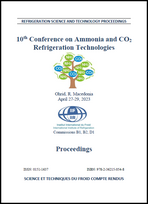
IIR document
Trends in heat pump technology in Denmark.
Number: 0005
Author(s) : HANSEN S. O. K., PEDERSEN S. V., ZÜHLSDORF B.
Summary
Since 2010, the Danish government has been working with the goal of making Denmark independent of coal, oil, and gas by 2050. The plan is to produce enough renewable energy to cover Danish energy consumption, and energy production is, therefore, undergoing a transition that also strives to obtain a stable and secure energy supply. The conversion follows two overall strategies: 1. To increase the proportion of renewable energy and 2. To ensure energy efficiency improvements. An increased electrification with, among other things, wind turbines as well as the installation of many small and large heat pumps for households and collective district heating for space heating and domestic hot water constitute important elements in the conversion. The invasion of Ukraine has caused the demand for heat pumps in Denmark to explode. In Denmark, work is being done to develop and use new heat pump technology - with a particular focus on high temperatures for industrial processes - to replace oil and gas. Focus is also put on flexible control of both small and large installations depending on electricity prices. Most of the large heat pumps use ammonia or CO2 as refrigerant.
Available documents
Format PDF
Pages: 12
Available
Public price
20 €
Member price*
Free
* Best rate depending on membership category (see the detailed benefits of individual and corporate memberships).
Details
- Original title: Trends in heat pump technology in Denmark.
- Record ID : 30030964
- Languages: English
- Source: 10th IIR Conference on Ammonia and CO2 Refrigeration Technologies.
- Publication date: 2023/04/27
- DOI: http://dx.doi.org/10.18462/iir.nh3-co2.2023.0005
Links
See other articles from the proceedings (38)
See the conference proceedings
Indexing
-
Themes:
Heat pumps techniques;
CO2;
Ammonia - Keywords: Denmark; Heat pump; Statistics; District heating; District cooling; R744; Ammonia; High temperature; Research
-
Mapping of coefficient of performance for large...
- Author(s) : JØRGENSEN P., OMMEN T., MARKUSSEN M., et al.
- Date : 2019/08/24
- Languages : English
- Source: Proceedings of the 25th IIR International Congress of Refrigeration: Montréal , Canada, August 24-30, 2019.
- Formats : PDF
View record
-
Design of an integrated energy system using a c...
- Author(s) : VOLPATO O., EIKEVIK T. M., GANESAN P., HAMID K.
- Date : 2024/08
- Languages : English
- Source: 16th IIR-Gustav Lorentzen Conference on Natural Refrigerants (GL2024). Proceedings. University of Maryland, College Park, Maryland, USA, August 11-14 2024
- Formats : PDF
View record
-
District heating, district cooling and desalina...
- Author(s) : PEARSON D. F., APPLETON S.
- Date : 2010/03/29
- Languages : English
- Source: 1st IIR International Conference on Sustainability and the Cold Chain
- Formats : PDF
View record
-
Performance optimization of a large-scale ammon...
- Author(s) : JØRGENSEN P., OMMEN T., MARKUSSEN W. B., et al.
- Date : 2019/04/11
- Languages : English
- Source: 8th Conference on Ammonia and CO2 Refrigeration Technology. Proceedings: Ohrid, North Macedonia, Avril 11-13, 2019.
- Formats : PDF
View record
-
Design and optimization of the heat exchanger n...
- Author(s) : HARTMUND JORGENSEN P., OMMEN T., MARKUSSEN W. B., et al.
- Date : 2018/06/18
- Languages : English
- Source: 13th IIR Gustav Lorentzen Conference on Natural Refrigerants (GL2018). Proceedings. Valencia, Spain, June 18-20th 2018.
- Formats : PDF
View record
